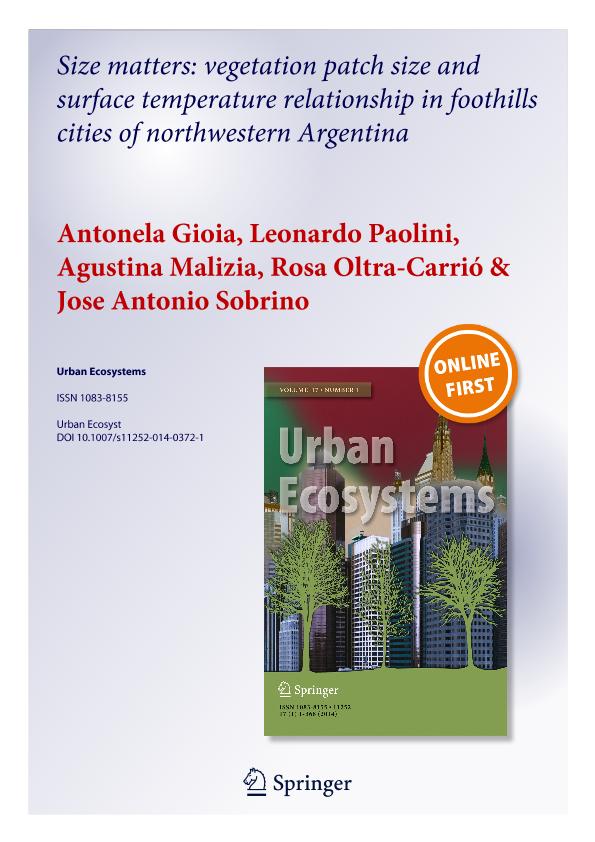Mostrar el registro sencillo del ítem
dc.contributor.author
Gioia, Antonela

dc.contributor.author
Paolini, Leonardo

dc.contributor.author
Malizia, Agustina

dc.contributor.author
Oltra Carrió, Rosa
dc.contributor.author
Sobrino, José Antonio
dc.date.available
2017-02-03T19:23:26Z
dc.date.issued
2014-12
dc.identifier.citation
Gioia, Antonela; Paolini, Leonardo; Malizia, Agustina; Oltra Carrió, Rosa; Sobrino, José Antonio; Size matters: vegetation patch size and surface temperature relationship in foothills cities of northwestern Argentina; Springer; Urban Ecosystems; 17; 4; 12-2014; 1161–1174
dc.identifier.issn
1083-8155
dc.identifier.uri
http://hdl.handle.net/11336/12465
dc.description.abstract
Urbanization is one of the most extreme forms of land alteration. Energy fluxes are severely affected and cities tend to have the Urban Heat Island (UHI) phenomenon, although vegetated areas inside cities could have a positive effect in mitigating UHI effect. Our main objective was to analyze the relationship between vegetation characteristics, patch size and land surface temperature (LST) in three urban areas of northwestern Argentina. We selected 38 green spaces of different size distributed in four cities, all located in the eastern foothills of the subtropical mountain forests. We used Landsat TM satellite images to calculate Normalized Difference Vegetation Index (NDVI) and LST. We assessed the net effect of patch size on LST by computing a Difference Temperature Index. At the regional scale, our results showed that vegetation patch size had a direct effect on reducing the LST of the green space. At a local scale, the analysis of the relationship between vegetation on urban green spaces and LST along a gradient of urbanization showed that green spaces with more vegetation tends to reduce LST. The results showed that largest green spaces were between 1.5 and 2.8 °C cooler than the surrounding built. In order to mitigate the UHI effect in cities, larger green spaces appear to be a possible solution.
dc.format
application/pdf
dc.language.iso
eng
dc.publisher
Springer

dc.rights
info:eu-repo/semantics/openAccess
dc.rights.uri
https://creativecommons.org/licenses/by-nc-sa/2.5/ar/
dc.subject
Urban Ecology
dc.subject
Normalized Difference Vegetation Index
dc.subject
Green Spaces
dc.subject
Urban Heat Island
dc.subject.classification
Ciencias Medioambientales

dc.subject.classification
Ciencias de la Tierra y relacionadas con el Medio Ambiente

dc.subject.classification
CIENCIAS NATURALES Y EXACTAS

dc.title
Size matters: vegetation patch size and surface temperature relationship in foothills cities of northwestern Argentina
dc.type
info:eu-repo/semantics/article
dc.type
info:ar-repo/semantics/artículo
dc.type
info:eu-repo/semantics/publishedVersion
dc.date.updated
2017-02-03T14:06:04Z
dc.identifier.eissn
1573-1642
dc.journal.volume
17
dc.journal.number
4
dc.journal.pagination
1161–1174
dc.journal.pais
Estados Unidos

dc.journal.ciudad
Nueva York
dc.description.fil
Fil: Gioia, Antonela. Universidad Nacional de Tucumán. Facultad de Ciencias Naturales E Instituto Miguel Lillo. Instituto de Ecología Regional; Argentina. Consejo Nacional de Investigaciones Científicas y Técnicas; Argentina
dc.description.fil
Fil: Paolini, Leonardo. Universidad Nacional de Tucumán. Facultad de Ciencias Naturales E Instituto Miguel Lillo. Instituto de Ecología Regional; Argentina. Consejo Nacional de Investigaciones Científicas y Técnicas; Argentina
dc.description.fil
Fil: Malizia, Agustina. Universidad Nacional de Tucumán. Facultad de Ciencias Naturales E Instituto Miguel Lillo. Instituto de Ecología Regional; Argentina. Consejo Nacional de Investigaciones Científicas y Técnicas; Argentina
dc.description.fil
Fil: Oltra Carrió, Rosa. Universidad de Valencia; España
dc.description.fil
Fil: Sobrino, José Antonio. Universidad Politecnica de Valencia; España
dc.journal.title
Urban Ecosystems
dc.relation.alternativeid
info:eu-repo/semantics/altIdentifier/doi/http://dx.doi.org/10.1007/s11252-014-0372-1
dc.relation.alternativeid
info:eu-repo/semantics/altIdentifier/url/http://link.springer.com/article/10.1007%2Fs11252-014-0372-1
Archivos asociados
